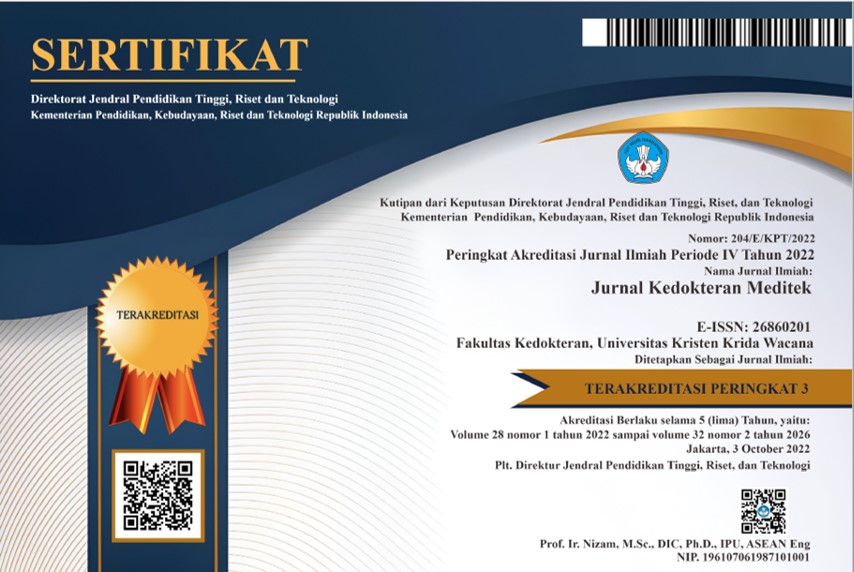Perbandingan Efektivitas Terapi Delayed-Onset Muscle Soreness: Studi Literatur
DOI:
https://doi.org/10.36452/jkdoktmeditek.v28i3.2328Keywords:
biomarker, cedera otot, DOMS, terapiAbstract
Delayed onset muscle soreness (DOMS) adalah salah satu tipe cedera otot yang terjadi saat berolahraga. Adanya DOMS ditandai dengan perasaan nyeri dan tidak nyaman pada otot yang digunakan secara berlebihan. Kondisi DOMS dapat berefek pada penurunan ruang gerak otot dan paralisis semu yang pada akhirnya dapat menyebabkan penurunan performa otot ke depannya. Mekanisme DOMS memiliki berbagai teori seperti asam laktat, spasme otot, kerusakan jaringan otot, kerusakan jaringan ikat, inflamasi, dan efluks enzim. Aktivitas fisik yang dapat memicu terjadinya DOMS adalah kontraksi eksentrik, yaitu kontraksi intensitas tinggi dan tidak biasa. Berbagai terapi yang dapat dilakukan adalah cold water immersion (CWI), contrast water immersion, cryotheraphy, kompresi, perbaikan aktif, Nonsteroidal Anti-Inflammatory Drugs (NSAID), massage, heat treatment, antioksidan, vibrasi, dan whole body cryotherapy. Studi menunjukkan bahwa tidak semua modalitas terapi dapat menurunkan persepsi nyeri pada DOMS maupun biomarker inflamasi dan kerusakan jaringan. Hasil efektivitas terapi sangat bervariasi mengikuti waktu saat diberikan atau dosisnya.
References
Piercy KL, Troiano RP, Ballard RM, Carlson SA, Fulton JE, Galuska DA, et al. The physical activity guidelines for Americans. JAMA. 2018;320(19):2020–8.
World Health Organization. Global recommendations on physical activity for health. 2010. 1–57. [cited 2021 Nov 11]. Available from: https://www.who.int/dietphysicalactivity/global-PA-recs-2010.pdf
Nystoriak MA, Bhatnagar A. Cardiovascular effects and benefits of exercise. Frontiers in Cardiovascular Medicine. 2018;5(September):1–11.
Cleak MJ, Eston RG. Delayed onset muscle soreness: mechanisms and management. Journal of Sports Sciences. 1992;10(4):325–41.
Bueno AM, Pilgaard M, Hulme A, Forsberg P, Ramskov D, Damsted C, et al. Injury prevalence across sports: a descriptive analysis on a representative sample of the Danish population. Injury Epidemiology. 2018;5(1).
Orihantoro Y. Prevalensi, karakteristik, dan penanganan delayed onset muscle soreness (DOMS) di Unit Kegiatan Mahasiswa (UKM) Olahraga Universitas Negeri Yogyakarta. Yogyakarta; 2018.
Zondi P, Janse van Rensburg D, Grant C, Jansen van Rensburg A. Delayed onset muscle soreness: no pain, no gain? The truth behind this adage. South African Family Practice. 2015;57(3):29–33.
Bleakley C, McDonough S, Gardner E, Baxter GD, Hopkins JT, Davison GW. Cold-water immersion (cryotherapy) for preventing and treating muscle soreness after exercise. Cochrane Database of Systematic Reviews 2012, Issue 2. [cited 2021 Nov 15]. Available from: https://www.ncbi.nlm.nih.gov/pmc/articles/PMC6492480/
Abaïdia AE, Lamblin J, Delecroix B, Leduc C, McCall A, Nédélec M, et al. Recovery from exercise-induced muscle damage: cold-water immersion versus whole-body cryotherapy. International Journal of Sports Physiology and Performance. 2017;12(3):402–9.
Hill J, Howatson G, van Someren K, Leeder J, Pedlar C. Compression garments and recovery from exercise-induced muscle damage: a meta-analysis. British journal of sports medicine. 2014;48(18):1340–6.
Morelli KM, Brown LB, Warren GL. Effect of NSAIDs on recovery from acute skeletal muscle injury: a systematic review and meta-analysis. American Journal of Sports Medicine. 2018;46(1):224–33.
Ranchordas MK, Rogerson D, Soltani H, Costello JT. Antioxidants for preventing and reducing muscle soreness after exercise. Vol. 2017, Cochrane Database of Systematic Reviews. John Wiley and Sons Ltd; 2017. [cited 2021 Nov 15]. Available from: https://www.ncbi.nlm.nih.gov/pmc/articles/PMC6486214/
Costello JT, Baker PRA, Minett GM, Bieuzen F, Stewart IB, Bleakley C. Whole-body cryotherapy (extreme cold air exposure) for preventing and treating muscle soreness after exercise in adults. Vol. 2015, Cochrane Database of Systematic Reviews. John Wiley and Sons Ltd; 2015. [cited 2021 Nov 15]. Available from: https://www.cochranelibrary.com/cdsr/doi/10.1002/14651858.CD010789.pub2/full
Guo J, Li L, Gong Y, Zhu R, Xu J, Zou J, et al. Massage alleviates delayed onset muscle soreness after strenuous exercise: a systematic review and meta-analysis. Vol. 8, Frontiers in Physiology. Frontiers Media S.A.; 2017. [cited 2021 Nov 16]. Available from: https://www.ncbi.nlm.nih.gov/pmc/articles/PMC5623674/
Higgins TR, Greene DA, Baker MK. Effects of cold water immersion and contrast water therapy for recovery from team sport: a systematic review and meta-analysis. Journal of Strength and Conditioning Research. 2017;31(5):1443–60.
Lu X, Wang Y, Lu J, You Y, Zhang L, Zhu D, et al. Does vibration benefit delayed-onset muscle soreness?: a meta-analysis and systematic review. Journal of International Medical Research. 2019;47(1):3–18.
Murray A, Cardinale M. Cold applications for recovery in adolescent athletes: a systematic review and meta analysis. Vol. 4, Extreme Physiology and Medicine. BioMed Central Ltd.; 2015. [cited 2021 Nov 16]. Available from: https://www.ncbi.nlm.nih.gov/pmc/articles/PMC4603811/
Hohenauer E, Taeymans J, Baeyens JP, Clarys P, Clijsen R. The effect of post-exercise cryotherapy on recovery characteristics: A systematic review and meta-analysis. PLoS ONE. 2015;10(9).
Petrofsky J, Berk L, Bains G, Khowailed IA, Lee H, Laymon M. The efficacy of sustained heat treatment on delayed-onset muscle soreness. 2016. [cited 2021 Nov 16]. Available from: https://journals.lww.com/cjsportsmed/Fulltext/2017/07000/The_Efficacy_of_Sustained_Heat_Treatment_on.1.aspx
Dupuy O, Douzi W, Theurot D, Bosquet L, Dugué B. An evidence-based approach for choosing post-exercise recovery techniques to reduce markers of muscle damage, Soreness, fatigue, and inflammation: a systematic review with meta-analysis. Frontiers in Physiology. 2018;9. [cited 2021 Nov 22]. Available from: https://www.ncbi.nlm.nih.gov/pmc/articles/PMC5932411/
Pollock N, James SLJ, Lee JC, Chakraverty R. British athletics muscle injury classification: a new grading system. British journal of sports medicine. 2014;48(18):1347–51.
Yu J-Y, Jeong J-G, Lee B-H. Evaluation of muscle damage using ultrasound imaging. J Phys Ther Sci. 2015;27:531–4.
Mizuno S, Morii I, Tsuchiya Y, Goto K. Wearing compression garment after endurance exercise promotes recovery of exercise performance. International Journal of Sports Medicine. 2016;37(11):870–7.
Schoenfeld BJ. The use of nonsteroidal anti-inflammatory drugs for exercise-induced muscle damage implications for skeletal muscle development. Sports Med. 2012;42(12):1017-28. [cited 2021 Nov 29]. Available from: https://pubmed.ncbi.nlm.nih.gov/23013520/
Field T. Massage therapy research review. Complementary therapies in clinical practice. 2016;24:19-31. [cited 2021 Nov 22]. Available from: https://www.ncbi.nlm.nih.gov/pmc/articles/PMC5564319/
Best TM, Crawford SK. Massage and postexercise recovery: the science is emerging. Vol. 51, British Journal of Sports Medicine. BMJ Publishing Group; 2017. p. 1386–7. [cited 2021 Nov 29]. Available from: https://bjsm.bmj.com/content/51/19/1386.long
Downloads
Published
How to Cite
Issue
Section
License
Copyright (c) 2022 Rebecca Olivia Haryuni, Hartanto, Budiman Hartono

This work is licensed under a Creative Commons Attribution-NonCommercial-ShareAlike 4.0 International License.

















